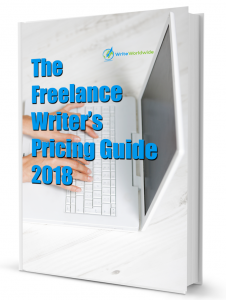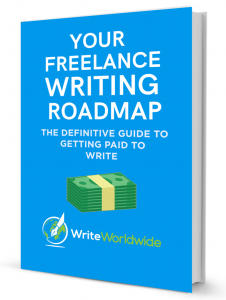If you’re writing for money and self-employed, you’re a freelance professional. One issue that gets discussed often in the freelance writing community is pricing.
How do you price yourself so clients are paying what you’re worth and you get to make a decent living at the same time?
It’s not always easy or straightforward to determine how to set your prices, but there are ways to experiment with your rates and services while you find out what’s right for you.
Here are three pricing tactics you can use to structure what you sell and adjust your writing rates for maximum revenue:
1. Anchoring and Adjustment Pricing.
The basic principle of anchoring and adjustment pricing is about placement. Let’s say you have a car that you want to sell for $5000. Some potential buyers come along. They like the look of the car, but they all say the same thing – that price is way too high! You’ve missed out on a sale and there’s nothing you can do, right?
Wrong. Leave your car where it is, but put another one next to it. Advertise the second car for sale at $50,000, and watch your previously astronomical $5000 sale get snapped up fast.
The beauty of anchoring and adjustment pricing is that you don’t need to change anything about the product or service you actually intend to sell – you simply need to place it alongside something that makes it seem like a steal.
$5000 is a huge amount of money, but in contrast to $50,000 it seems extremely cheap.
You can use this technique to market yourself effectively and sell your writing services as a freelance professional – for example, you could offer blog posting as your primary service at $200, alongside more expensive options that you don’t necessarily expect clients to go for.
Try it, and see how many more deals you can close!
2. Charm Pricing
Charm pricing works based on how our brains perceive and process numbers. It specifically involves the number 9, and a cognitive phenomenon known as the ‘left-digit effect’.
Research has found that ending your prices with a 9 has a powerful effect on buying decisions. When processing pricing, if a number ending in zero is lowered by a cent – for example $20 to $19.99 – our brains then see the 9 as shorthand for ‘this deal is a bargain’.
But it doesn’t stop there. This psychological loophole works so well that products with a price tag ending in a 9 will invariably fare better than those that don’t – even if those that don’t are less expensive.
In a University of Chicago study, clothing priced at $39 sold better than the same items priced at $34, all thanks to the ‘left-digit effect’ and the way our brains analyse numbers before we even realise we’re looking at them.
As a freelance professional you can take advantage of this technique, and price yourself accordingly.
Put together a couple of pricing bundles based on your most popular writing services.
If you advertise one at $54, and one at $99.99, you might be surprised which one sells faster.
3. Premium Pricing
if you’re just starting out on your freelance writing journey, you’ll have seen and heard plenty of stories about low-paying content mills and how they shamelessly target newbie writers who are desperate to make money.
They know that these writers will take on all manner of $5 and $10 writing jobs, often sacrificing the quality of the work they produce in the process.
Premium pricing takes this business model and turns it on its head. Let’s go back for a moment to those two hypothetical cars you’re using to attract potential buyers – one at $5000, the other at $50,000.
Now imagine yourself as a buyer. Which car do you assume will be the most luxurious, and give you the best possible experience?
Obviously, that’s going to be the $50,000 car. The higher the price tag, the higher the perceived value. When it comes to pricing, ‘you get what you pay for’ is our default setting, and we’re psychologically programmed to equate a high price with a quality service.
If you want to attract high-paying clients and be regarded as a bona fide freelance professional in your writing career, why not show true confidence in your abilities and experiment with some premium pricing tactics?
If you constantly accept work that pays low, you’ll probably have trouble ever breaking out of that cycle. Go high and market yourself at a premium level, and you’re giving yourself the best chance for longevity and success.
Do you plan to try out some of these pricing techniques, or have a formula that works for you? Let us know in the comments!
Once you’ve settled on a pricing strategy you’ll need to start pitching to clients and it just so happens that we’ve got the perfect cold pitching template right here. Fill out the form below and we’ll send you Nick’s cold pitch template that landed him a $250 per blog post client.




What a fun and helpful set of ways of looking at pricing. Will surely keep this in mind!
Thanks Kate! I’m experimenting with this myself at the moment so I enjoyed putting it together 🙂
Awesome post.